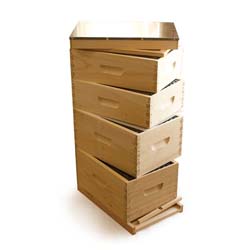Introduction
One of the most enjoyable aspects of beekeeping is that our bees are so incredibly self-sufficient. Once a colony is established, it has the ability to locate, retrieve, and use resources from miles away, as well as “manufacture” honey for its future needs.
As a general rule, if bees have a way of taking care of themselves then that’s the path we prefer to see, as beekeepers. Intervention with an established and healthy colony is rarely needed. Remember that wild hives have been observed to exist for centuries, with no help from us humans!
Yet there are some situations where our bees can use a helping hand. In the big scheme of things, these situations are brief, specific and may involve the use of a feeder. This is a piece of equipment through which beekeepers can make additional resources available to their bees. Of all the components or accessories available for beehives, the feeder is a popular option.
In this lesson, we look at when feeding might be appropriate, what to feed and the various types of feeders available.
Why Use Feeders?
Let’s start with a simple observation. If you leave a feeder on your hive through the entire summer, you are doing it wrong! The whole idea of a feeder is to provide a very focused helping hand to our bees, with the intention to let them take care of themselves at all other times. The natural resources available to bees through foraging are far better suited to their needs than anything we might offer them.
When Establishing a Colony
Probably the most obvious and justified time to use a feeder is when a new colony is being established, particularly after being introduced as a package. At that time you are placing your bees into a new home with absolutely no resources. Without feeding you are essentially asking hungry bees to leave the hive and gather their own food. This puts them at significant risk if they can’t gather sufficient resources quickly enough to get established.
Therefore it is common to install a feeder when a hive is first set up with a package of bees.
When installing a nuc (we will look at the difference in a future lesson). the colony is a little more established. The nuc includes bees in all stages of development, from egg to adult. But, importantly. it also includes a number of frames holding honey and pollen. These are valuable to the colony as it starts to expand beyond the 5 or so frames in which it was supplied. However, even in this situation, there is often value in adding a feeder just to help the bees establish themselves still further.
With Winter Approaching
Generally, your bees will have used the summer and fall well and built up sufficient reserves for the winter. In some situations, depending on the environment, the honey flow, and so on, the beekeeper may want to help the bees along, by feeding in fall and as winter approaches.
This isn’t always necessary and the best situation of all is when the bees have built sufficient reserves of their own, to make it through the winter. Don’t feed “just because ” – assess the need and decide at that time.
Types of Feeders
Entrance Feeder
Entrance feeders, as the name implies, sit at the entrance to the beehive and are best suited to Langstroth or Warre beehives (though some folks have been known to place them in Top Bar hives). The basic design is normally very simple, with a feeding jar sitting on a wood platform that fits into the entrance of the hive. The bees access the food through holes in the lid of the inverted jar.
The biggest disadvantage – and the reason some beekeepers never use entrance feeders – is that their positioning on the outside of the beehive is a potential invitation to robber bees.
Hive Top Feeder
Hive top feeders sit on top of the upper box, aligned with a hole in the inner cover. There are various types of hive top feeders available, with a common option being an inverted mason jar, with small holes in the downward-facing lid. The vacuum above the syrup means that drops are available from which bees can eat.
Hive top feeders vary in volume, from 1-4 mason jars to larger units and some units are designed with a few more features.
Typically, an empty hive box is placed around the hive top feeder. This protects the feeder from both robbers and the elements. While this means checking remaining food is not “at a glance”, it is still very simple to remove the extra box to take a look. This is often a simple decision for a beekeeper, since one or more boxes that came with their hive purchase will be unused initially, so re-purposing one box to protect a hive top feeder is straightforward.
Frame Feeder
Sometimes referred to as a division board feeder, the frame feeder replaces one of the frames in a Langstroth hive. To prevent drowning, such feeders typically feature a built-in float on which the bees can rest when they feed.
An advantage of this type of feeder is that it is housed entirely within the beehive, so there is no threat from robbers. A disadvantage is that feed levels can only be checked by inspecting the hive.
When to Stop Feeding
Remember that feeding bees should be considered a temporary measure, rather than an ongoing process. As your colony establishes itself and foraging increases, their reliance on the food we offer falls off.
Providing the bees have a varied and rich source of foraging in flying distance, they will start leaving food in the feeder. As this falls off and you see the colony grow in strength, it is time to remove the feeder.
